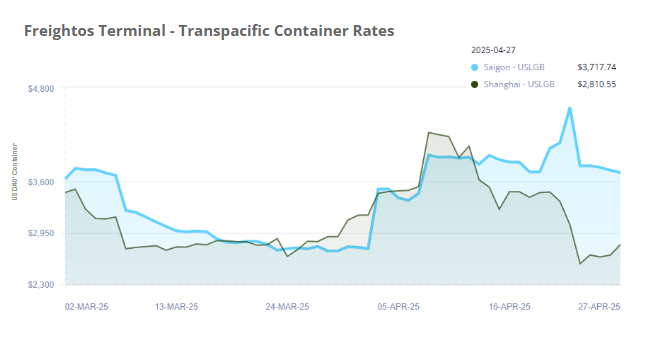Understanding the Shift in Freight Trends
Shipping dynamics in Asia are shifting significantly, with new trends emerging in international freight logistics. Recently, a notable drop in shipping volumes from China has been observed, coinciding with a spike in demand from Southeast Asia. This change is not just a blip on the radar; it reflects deeper economic trends influencing global logistics.
Weekly Highlights of Freight Trends
Based on recent updates, several important highlights have emerged:
- Shipping prices from China to Northern Europe have decreased by 1%, settling at approximately $3.71/kg.
- There is a more pronounced decline of 5% in prices from Northern Europe to North America, resulting in about $2.01/kg.
Analysis of Economic Influences
A key factor influencing this drastic change has been the imposition of significant tariffs—reportedly as high as 145%—on imports from China. These tariffs have prompted numerous US importers to rethink their supply chains, leading to canceled orders and delayed shipments. The hope is that upcoming negotiations between affected parties will lead to a reduction in these tariffs, easing some of the pressure on both the importers and consumers.
Currently, reports suggest a staggering reduction in shipping demand between China and the US, estimated to be between 30% to over 50% in recent weeks. In light of this downturn, shipping carriers are responding by significantly reducing the number of available sailings. Estimates indicate that around 28% of transpacific shipping capacity will be unusable for West Coast traffic, while about 42% may be affected on the East Coast.
Impact on Inventory and Consumer Goods
Interestingly, many US importers have strategically built up inventory in anticipation of these tariffs. As such, they find themselves in a position to halt shipments from China temporarily. However, this stockpile might lead to shortages in the coming months, especially for consumer goods commonly sourced from China, such as toys and sporting equipment. If these inventory levels aren’t replenished soon, we could see significant price surges as importers grapple with tariff costs.
Emerging Trends from Southeast Asia
Despite the adversity faced by shipments from China, other Southeast Asian countries are experiencing a surge in demand. Some reports indicate that bookings from this region to the US have jumped nearly 20% recently. This trend is anticipated to offset some of the drop in demand from China, but shipping companies must brace for possible congestion and delays due to a rapid influx of demand.
In terms of operational capacity, the shifts in trade dynamics can lead to unintended bottlenecks as carriers attempt to realign their shipping routes and distribute resources effectively. There’s a fine line to walk here; a rapid increase in freight volume could result in significant logistical hurdles if not managed properly.
Container Rates and Market Stability
As shipping rates fluctuate, analysts suggest that this ongoing reduction in container utilization might actually help stabilize prices moving forward. It’s curious, however, that prices from some Southeast Asian ports have remained steady or even increased despite the changes in demand patterns. For instance, freight rates to Long Beach from both Shanghai and Vietnam witnessed considerable increases before the recent tariff announcements, further widening the gap between these destinations in terms of freight costs.
The Future of Air Cargo
While ocean freight experiences significant turmoil, the air cargo sector appears somewhat insulated from the same volatility, largely due to tariff exemptions for certain items such as electronics. Last week, the Freightos Air Index noted rates of approximately $5.58/kg for China-US air cargo. However, with the impending suspension of certain exemptions, air cargo rates and volumes are expected to undergo notable changes, potentially complicating logistics even further.
Conclusion on Logistics Dynamics
The current shipping landscape, driven by fluctuating demand and rising tariffs, presents both challenges and opportunities within the logistics sector. As businesses obtain keen insights into these trends, adapting to shifts will be crucial in optimizing their supply chains. Companies like GetTransport.com offer global cargo transportation solutions, ensuring that transitions in logistics can be smooth and cost-effective. They provide a suite of options for transporting everything from personal items to large freight—perfectly bridging logistics gaps in this constantly evolving market.
This exploration of the logistics and freight industries underscores the importance of staying adaptable in the ever-changing world of shipping. Even though reviews and analyses provide vital insights, nothing compares to personal experience when it comes to navigating this intricate landscape. With GetTransport.com, individuals and businesses alike can secure the best rates for their cargo needs and shipping arrangements, ultimately aiding informed decision-making without unnecessary costs or disappointments. Experience the convenience and affordability GetTransport.com offers. Book your transportation needs today at GetTransport.com.

